Jaguar Case Study: Business Essentials, Market Analysis & Strategy
VerifiedAdded on 2024/06/10
|16
|3157
|421
Case Study
AI Summary
This case study provides a comprehensive overview of Jaguar, a British multinational car manufacturer specializing in luxury vehicles. It delves into the company's history, from its origins as the Swallow Sidecar Company to its acquisition by Tata Motors. The analysis covers Jaguar's product line, marketing strategies, and recent developments, including the introduction of new models and technologies. A SWOT analysis highlights the company's strengths, weaknesses, opportunities, and threats, offering insights into its competitive position in the luxury car market. The case study also examines Jaguar's key competitors, such as Audi, BMW, and Mercedes-Benz, and concludes with recommendations for future growth and success. Desklib offers a wide range of solved assignments and study resources for students.
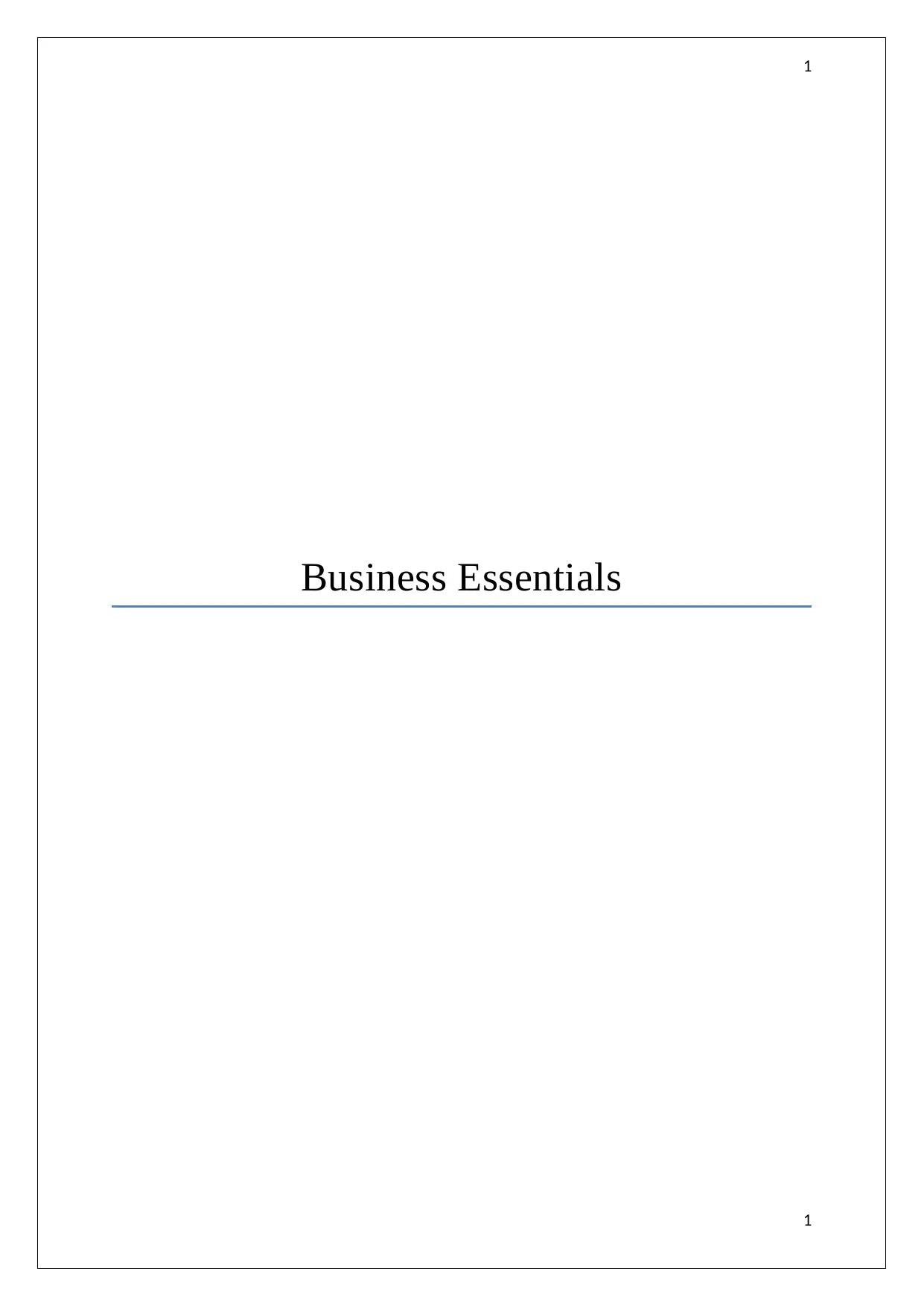
1
Business Essentials
1
Business Essentials
1
Paraphrase This Document
Need a fresh take? Get an instant paraphrase of this document with our AI Paraphraser
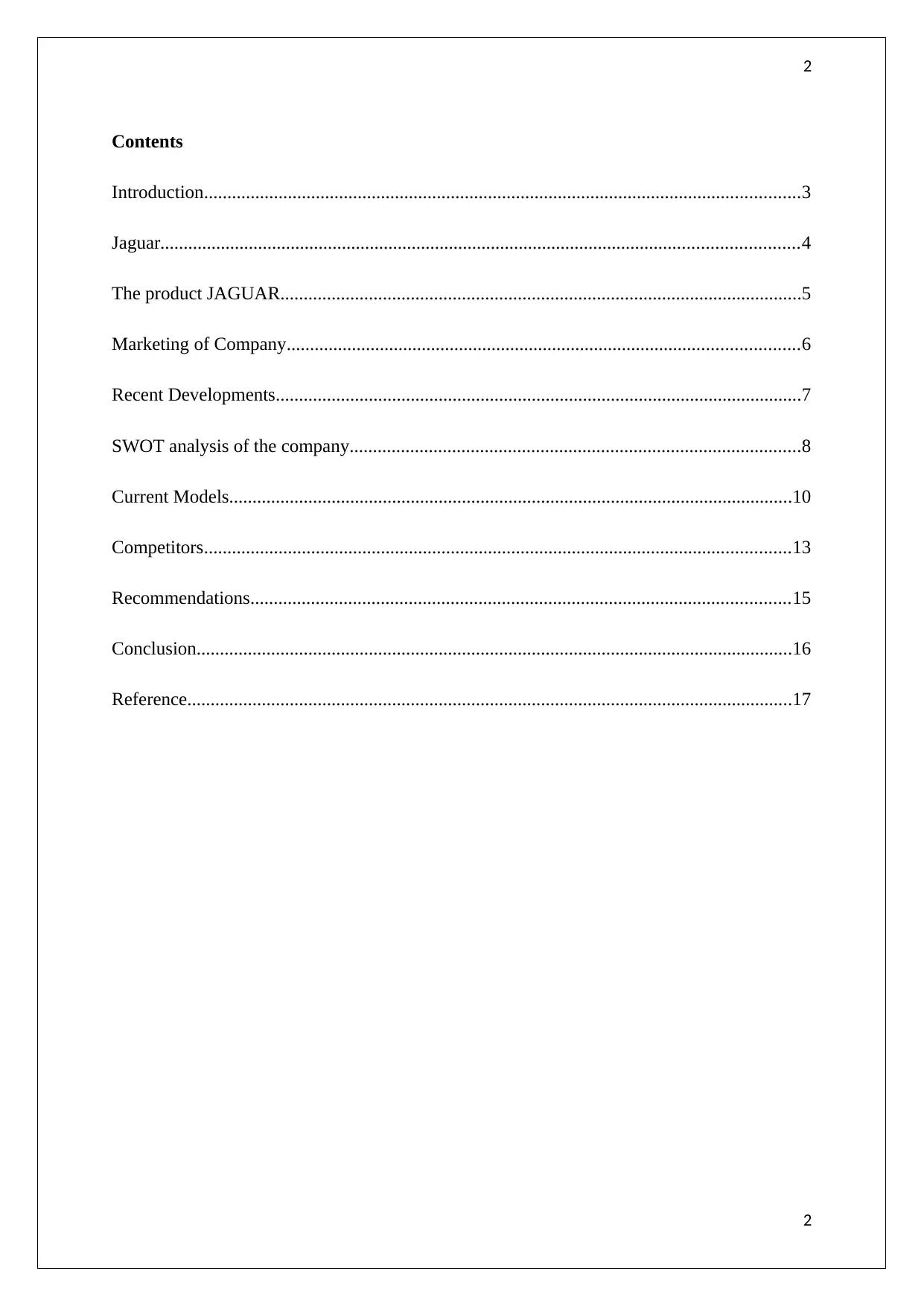
2
Contents
Introduction................................................................................................................................3
Jaguar.........................................................................................................................................4
The product JAGUAR................................................................................................................5
Marketing of Company..............................................................................................................6
Recent Developments.................................................................................................................7
SWOT analysis of the company.................................................................................................8
Current Models.........................................................................................................................10
Competitors..............................................................................................................................13
Recommendations....................................................................................................................15
Conclusion................................................................................................................................16
Reference..................................................................................................................................17
2
Contents
Introduction................................................................................................................................3
Jaguar.........................................................................................................................................4
The product JAGUAR................................................................................................................5
Marketing of Company..............................................................................................................6
Recent Developments.................................................................................................................7
SWOT analysis of the company.................................................................................................8
Current Models.........................................................................................................................10
Competitors..............................................................................................................................13
Recommendations....................................................................................................................15
Conclusion................................................................................................................................16
Reference..................................................................................................................................17
2
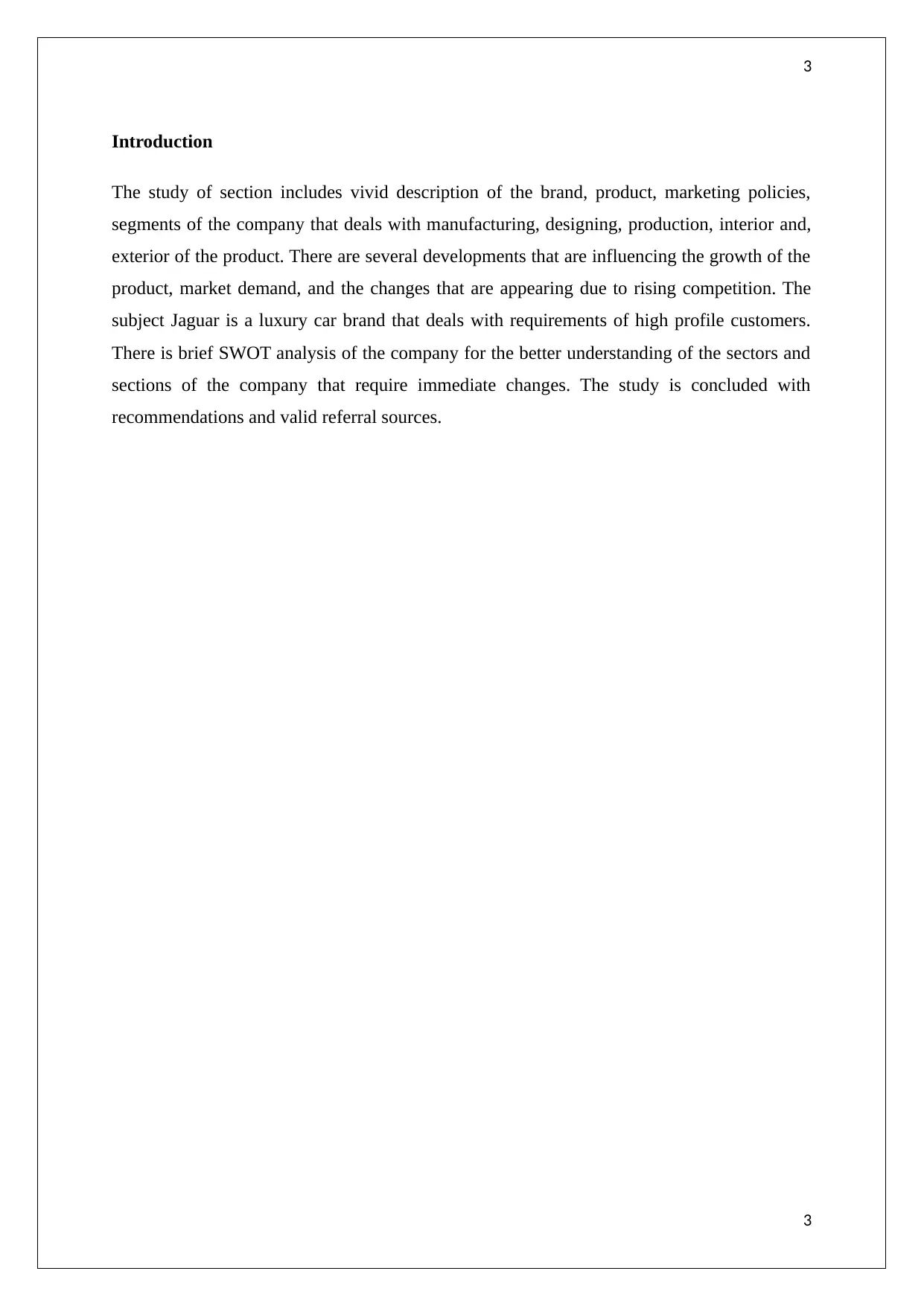
3
Introduction
The study of section includes vivid description of the brand, product, marketing policies,
segments of the company that deals with manufacturing, designing, production, interior and,
exterior of the product. There are several developments that are influencing the growth of the
product, market demand, and the changes that are appearing due to rising competition. The
subject Jaguar is a luxury car brand that deals with requirements of high profile customers.
There is brief SWOT analysis of the company for the better understanding of the sectors and
sections of the company that require immediate changes. The study is concluded with
recommendations and valid referral sources.
3
Introduction
The study of section includes vivid description of the brand, product, marketing policies,
segments of the company that deals with manufacturing, designing, production, interior and,
exterior of the product. There are several developments that are influencing the growth of the
product, market demand, and the changes that are appearing due to rising competition. The
subject Jaguar is a luxury car brand that deals with requirements of high profile customers.
There is brief SWOT analysis of the company for the better understanding of the sectors and
sections of the company that require immediate changes. The study is concluded with
recommendations and valid referral sources.
3
⊘ This is a preview!⊘
Do you want full access?
Subscribe today to unlock all pages.

Trusted by 1+ million students worldwide
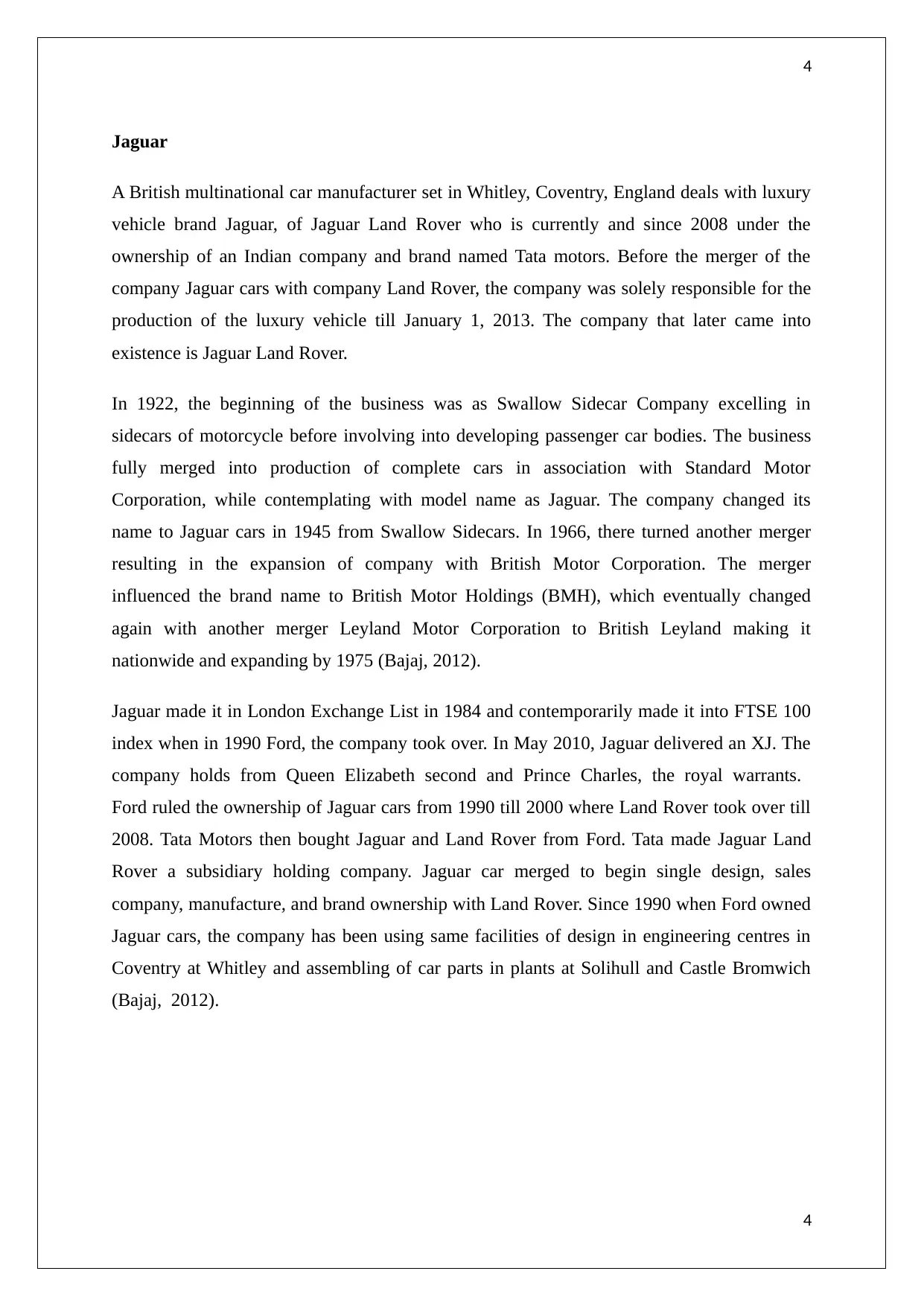
4
Jaguar
A British multinational car manufacturer set in Whitley, Coventry, England deals with luxury
vehicle brand Jaguar, of Jaguar Land Rover who is currently and since 2008 under the
ownership of an Indian company and brand named Tata motors. Before the merger of the
company Jaguar cars with company Land Rover, the company was solely responsible for the
production of the luxury vehicle till January 1, 2013. The company that later came into
existence is Jaguar Land Rover.
In 1922, the beginning of the business was as Swallow Sidecar Company excelling in
sidecars of motorcycle before involving into developing passenger car bodies. The business
fully merged into production of complete cars in association with Standard Motor
Corporation, while contemplating with model name as Jaguar. The company changed its
name to Jaguar cars in 1945 from Swallow Sidecars. In 1966, there turned another merger
resulting in the expansion of company with British Motor Corporation. The merger
influenced the brand name to British Motor Holdings (BMH), which eventually changed
again with another merger Leyland Motor Corporation to British Leyland making it
nationwide and expanding by 1975 (Bajaj, 2012).
Jaguar made it in London Exchange List in 1984 and contemporarily made it into FTSE 100
index when in 1990 Ford, the company took over. In May 2010, Jaguar delivered an XJ. The
company holds from Queen Elizabeth second and Prince Charles, the royal warrants.
Ford ruled the ownership of Jaguar cars from 1990 till 2000 where Land Rover took over till
2008. Tata Motors then bought Jaguar and Land Rover from Ford. Tata made Jaguar Land
Rover a subsidiary holding company. Jaguar car merged to begin single design, sales
company, manufacture, and brand ownership with Land Rover. Since 1990 when Ford owned
Jaguar cars, the company has been using same facilities of design in engineering centres in
Coventry at Whitley and assembling of car parts in plants at Solihull and Castle Bromwich
(Bajaj, 2012).
4
Jaguar
A British multinational car manufacturer set in Whitley, Coventry, England deals with luxury
vehicle brand Jaguar, of Jaguar Land Rover who is currently and since 2008 under the
ownership of an Indian company and brand named Tata motors. Before the merger of the
company Jaguar cars with company Land Rover, the company was solely responsible for the
production of the luxury vehicle till January 1, 2013. The company that later came into
existence is Jaguar Land Rover.
In 1922, the beginning of the business was as Swallow Sidecar Company excelling in
sidecars of motorcycle before involving into developing passenger car bodies. The business
fully merged into production of complete cars in association with Standard Motor
Corporation, while contemplating with model name as Jaguar. The company changed its
name to Jaguar cars in 1945 from Swallow Sidecars. In 1966, there turned another merger
resulting in the expansion of company with British Motor Corporation. The merger
influenced the brand name to British Motor Holdings (BMH), which eventually changed
again with another merger Leyland Motor Corporation to British Leyland making it
nationwide and expanding by 1975 (Bajaj, 2012).
Jaguar made it in London Exchange List in 1984 and contemporarily made it into FTSE 100
index when in 1990 Ford, the company took over. In May 2010, Jaguar delivered an XJ. The
company holds from Queen Elizabeth second and Prince Charles, the royal warrants.
Ford ruled the ownership of Jaguar cars from 1990 till 2000 where Land Rover took over till
2008. Tata Motors then bought Jaguar and Land Rover from Ford. Tata made Jaguar Land
Rover a subsidiary holding company. Jaguar car merged to begin single design, sales
company, manufacture, and brand ownership with Land Rover. Since 1990 when Ford owned
Jaguar cars, the company has been using same facilities of design in engineering centres in
Coventry at Whitley and assembling of car parts in plants at Solihull and Castle Bromwich
(Bajaj, 2012).
4
Paraphrase This Document
Need a fresh take? Get an instant paraphrase of this document with our AI Paraphraser
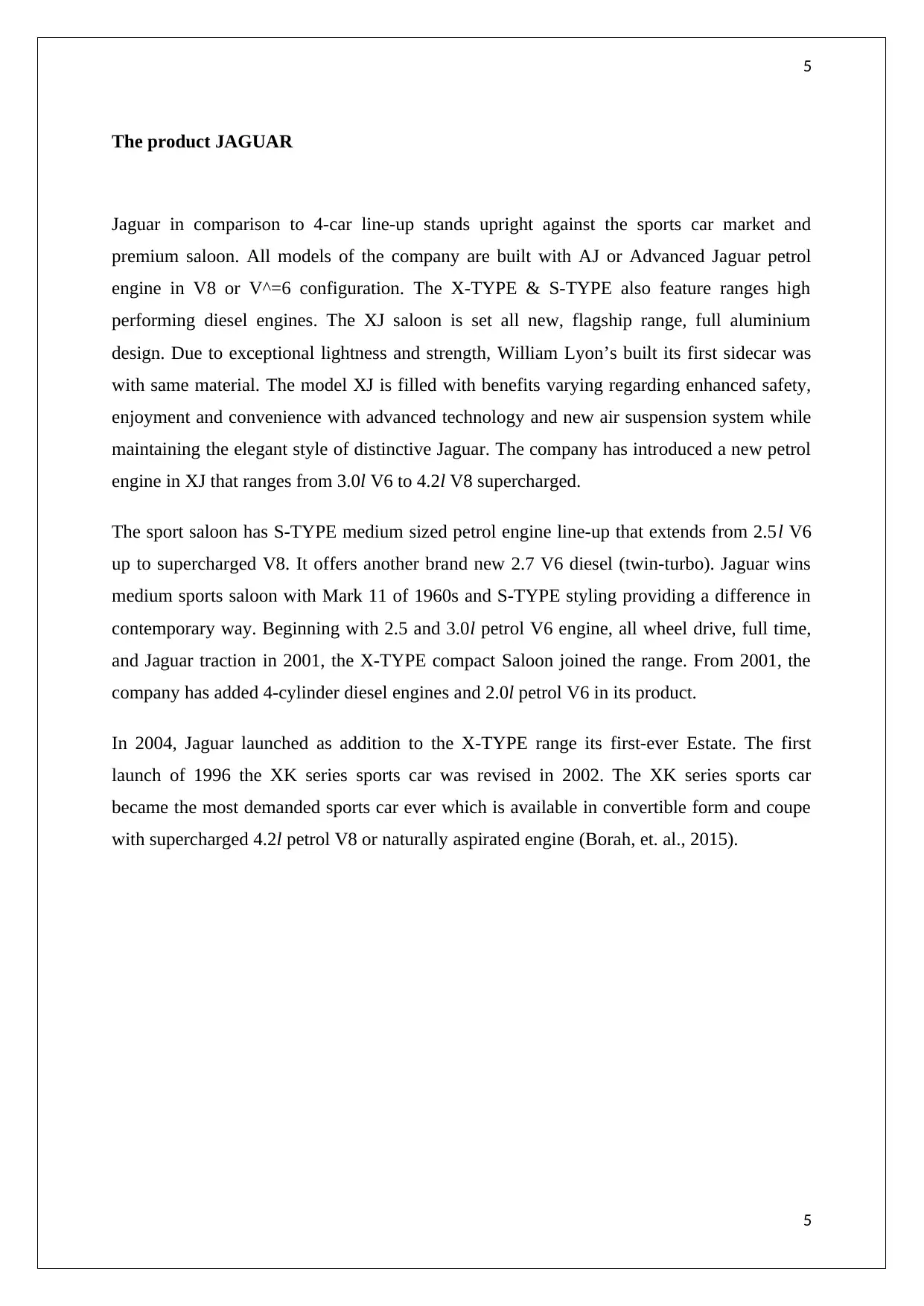
5
The product JAGUAR
Jaguar in comparison to 4-car line-up stands upright against the sports car market and
premium saloon. All models of the company are built with AJ or Advanced Jaguar petrol
engine in V8 or V^=6 configuration. The X-TYPE & S-TYPE also feature ranges high
performing diesel engines. The XJ saloon is set all new, flagship range, full aluminium
design. Due to exceptional lightness and strength, William Lyon’s built its first sidecar was
with same material. The model XJ is filled with benefits varying regarding enhanced safety,
enjoyment and convenience with advanced technology and new air suspension system while
maintaining the elegant style of distinctive Jaguar. The company has introduced a new petrol
engine in XJ that ranges from 3.0l V6 to 4.2l V8 supercharged.
The sport saloon has S-TYPE medium sized petrol engine line-up that extends from 2.5l V6
up to supercharged V8. It offers another brand new 2.7 V6 diesel (twin-turbo). Jaguar wins
medium sports saloon with Mark 11 of 1960s and S-TYPE styling providing a difference in
contemporary way. Beginning with 2.5 and 3.0l petrol V6 engine, all wheel drive, full time,
and Jaguar traction in 2001, the X-TYPE compact Saloon joined the range. From 2001, the
company has added 4-cylinder diesel engines and 2.0l petrol V6 in its product.
In 2004, Jaguar launched as addition to the X-TYPE range its first-ever Estate. The first
launch of 1996 the XK series sports car was revised in 2002. The XK series sports car
became the most demanded sports car ever which is available in convertible form and coupe
with supercharged 4.2l petrol V8 or naturally aspirated engine (Borah, et. al., 2015).
5
The product JAGUAR
Jaguar in comparison to 4-car line-up stands upright against the sports car market and
premium saloon. All models of the company are built with AJ or Advanced Jaguar petrol
engine in V8 or V^=6 configuration. The X-TYPE & S-TYPE also feature ranges high
performing diesel engines. The XJ saloon is set all new, flagship range, full aluminium
design. Due to exceptional lightness and strength, William Lyon’s built its first sidecar was
with same material. The model XJ is filled with benefits varying regarding enhanced safety,
enjoyment and convenience with advanced technology and new air suspension system while
maintaining the elegant style of distinctive Jaguar. The company has introduced a new petrol
engine in XJ that ranges from 3.0l V6 to 4.2l V8 supercharged.
The sport saloon has S-TYPE medium sized petrol engine line-up that extends from 2.5l V6
up to supercharged V8. It offers another brand new 2.7 V6 diesel (twin-turbo). Jaguar wins
medium sports saloon with Mark 11 of 1960s and S-TYPE styling providing a difference in
contemporary way. Beginning with 2.5 and 3.0l petrol V6 engine, all wheel drive, full time,
and Jaguar traction in 2001, the X-TYPE compact Saloon joined the range. From 2001, the
company has added 4-cylinder diesel engines and 2.0l petrol V6 in its product.
In 2004, Jaguar launched as addition to the X-TYPE range its first-ever Estate. The first
launch of 1996 the XK series sports car was revised in 2002. The XK series sports car
became the most demanded sports car ever which is available in convertible form and coupe
with supercharged 4.2l petrol V8 or naturally aspirated engine (Borah, et. al., 2015).
5
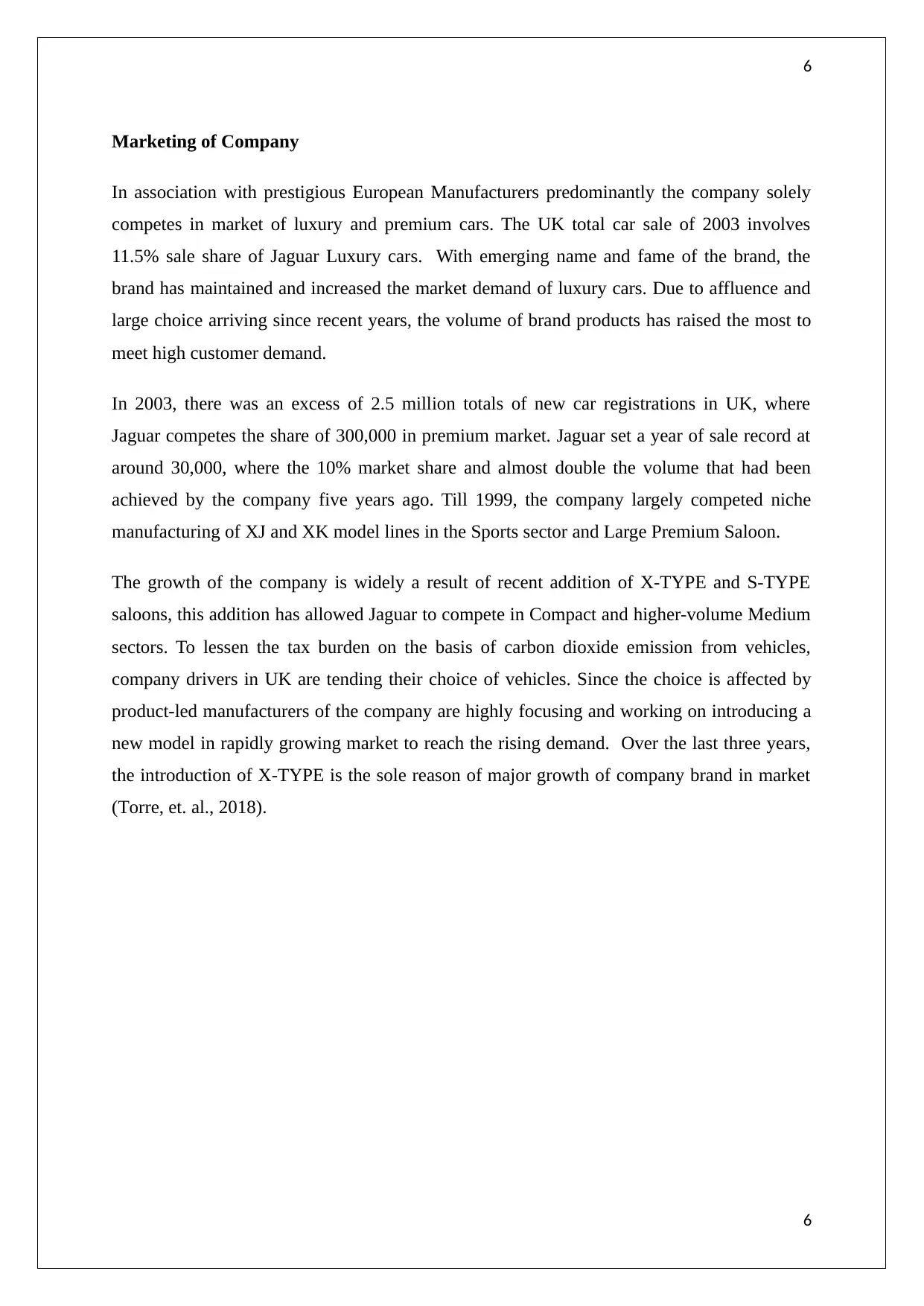
6
Marketing of Company
In association with prestigious European Manufacturers predominantly the company solely
competes in market of luxury and premium cars. The UK total car sale of 2003 involves
11.5% sale share of Jaguar Luxury cars. With emerging name and fame of the brand, the
brand has maintained and increased the market demand of luxury cars. Due to affluence and
large choice arriving since recent years, the volume of brand products has raised the most to
meet high customer demand.
In 2003, there was an excess of 2.5 million totals of new car registrations in UK, where
Jaguar competes the share of 300,000 in premium market. Jaguar set a year of sale record at
around 30,000, where the 10% market share and almost double the volume that had been
achieved by the company five years ago. Till 1999, the company largely competed niche
manufacturing of XJ and XK model lines in the Sports sector and Large Premium Saloon.
The growth of the company is widely a result of recent addition of X-TYPE and S-TYPE
saloons, this addition has allowed Jaguar to compete in Compact and higher-volume Medium
sectors. To lessen the tax burden on the basis of carbon dioxide emission from vehicles,
company drivers in UK are tending their choice of vehicles. Since the choice is affected by
product-led manufacturers of the company are highly focusing and working on introducing a
new model in rapidly growing market to reach the rising demand. Over the last three years,
the introduction of X-TYPE is the sole reason of major growth of company brand in market
(Torre, et. al., 2018).
6
Marketing of Company
In association with prestigious European Manufacturers predominantly the company solely
competes in market of luxury and premium cars. The UK total car sale of 2003 involves
11.5% sale share of Jaguar Luxury cars. With emerging name and fame of the brand, the
brand has maintained and increased the market demand of luxury cars. Due to affluence and
large choice arriving since recent years, the volume of brand products has raised the most to
meet high customer demand.
In 2003, there was an excess of 2.5 million totals of new car registrations in UK, where
Jaguar competes the share of 300,000 in premium market. Jaguar set a year of sale record at
around 30,000, where the 10% market share and almost double the volume that had been
achieved by the company five years ago. Till 1999, the company largely competed niche
manufacturing of XJ and XK model lines in the Sports sector and Large Premium Saloon.
The growth of the company is widely a result of recent addition of X-TYPE and S-TYPE
saloons, this addition has allowed Jaguar to compete in Compact and higher-volume Medium
sectors. To lessen the tax burden on the basis of carbon dioxide emission from vehicles,
company drivers in UK are tending their choice of vehicles. Since the choice is affected by
product-led manufacturers of the company are highly focusing and working on introducing a
new model in rapidly growing market to reach the rising demand. Over the last three years,
the introduction of X-TYPE is the sole reason of major growth of company brand in market
(Torre, et. al., 2018).
6
⊘ This is a preview!⊘
Do you want full access?
Subscribe today to unlock all pages.

Trusted by 1+ million students worldwide
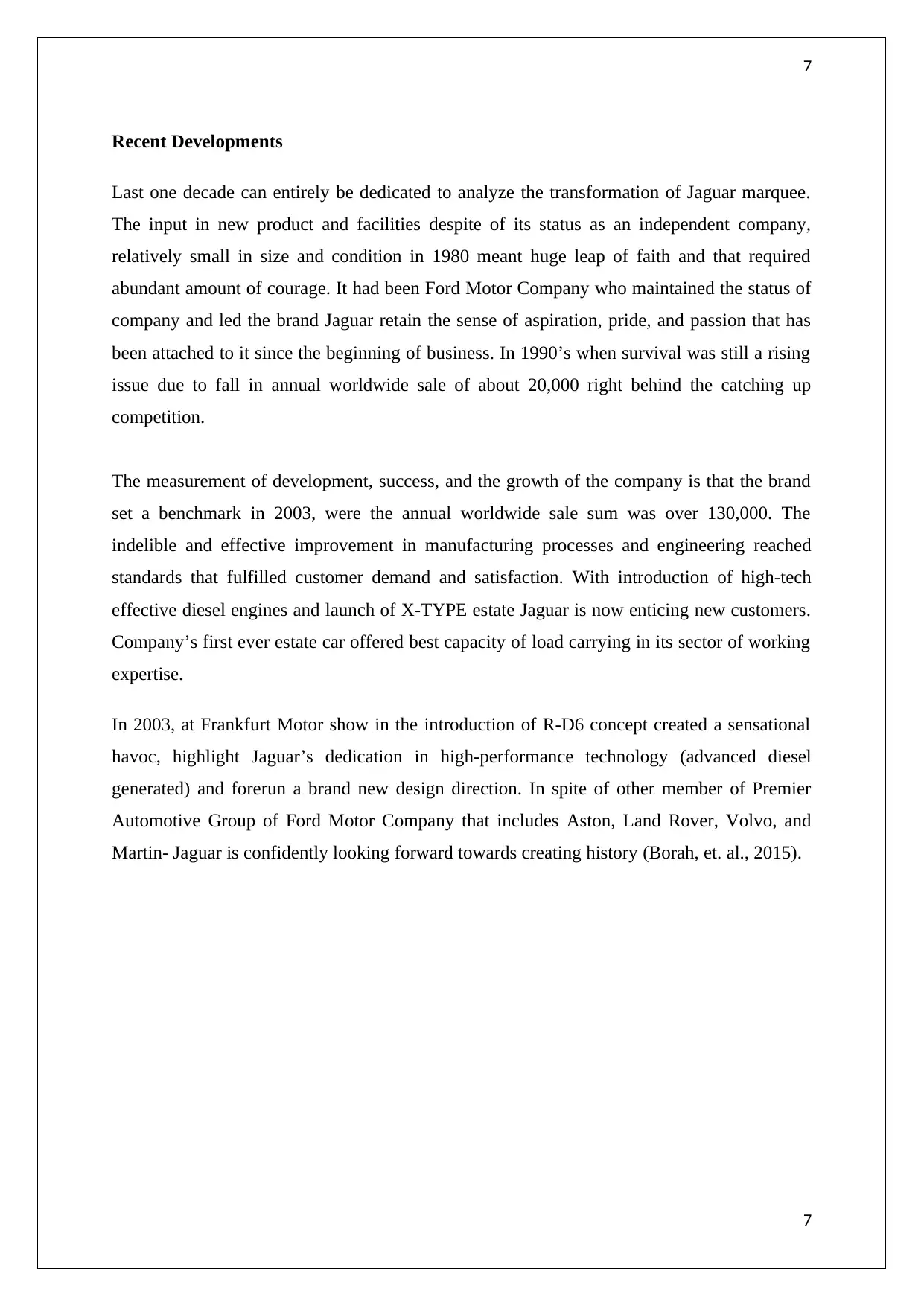
7
Recent Developments
Last one decade can entirely be dedicated to analyze the transformation of Jaguar marquee.
The input in new product and facilities despite of its status as an independent company,
relatively small in size and condition in 1980 meant huge leap of faith and that required
abundant amount of courage. It had been Ford Motor Company who maintained the status of
company and led the brand Jaguar retain the sense of aspiration, pride, and passion that has
been attached to it since the beginning of business. In 1990’s when survival was still a rising
issue due to fall in annual worldwide sale of about 20,000 right behind the catching up
competition.
The measurement of development, success, and the growth of the company is that the brand
set a benchmark in 2003, were the annual worldwide sale sum was over 130,000. The
indelible and effective improvement in manufacturing processes and engineering reached
standards that fulfilled customer demand and satisfaction. With introduction of high-tech
effective diesel engines and launch of X-TYPE estate Jaguar is now enticing new customers.
Company’s first ever estate car offered best capacity of load carrying in its sector of working
expertise.
In 2003, at Frankfurt Motor show in the introduction of R-D6 concept created a sensational
havoc, highlight Jaguar’s dedication in high-performance technology (advanced diesel
generated) and forerun a brand new design direction. In spite of other member of Premier
Automotive Group of Ford Motor Company that includes Aston, Land Rover, Volvo, and
Martin- Jaguar is confidently looking forward towards creating history (Borah, et. al., 2015).
7
Recent Developments
Last one decade can entirely be dedicated to analyze the transformation of Jaguar marquee.
The input in new product and facilities despite of its status as an independent company,
relatively small in size and condition in 1980 meant huge leap of faith and that required
abundant amount of courage. It had been Ford Motor Company who maintained the status of
company and led the brand Jaguar retain the sense of aspiration, pride, and passion that has
been attached to it since the beginning of business. In 1990’s when survival was still a rising
issue due to fall in annual worldwide sale of about 20,000 right behind the catching up
competition.
The measurement of development, success, and the growth of the company is that the brand
set a benchmark in 2003, were the annual worldwide sale sum was over 130,000. The
indelible and effective improvement in manufacturing processes and engineering reached
standards that fulfilled customer demand and satisfaction. With introduction of high-tech
effective diesel engines and launch of X-TYPE estate Jaguar is now enticing new customers.
Company’s first ever estate car offered best capacity of load carrying in its sector of working
expertise.
In 2003, at Frankfurt Motor show in the introduction of R-D6 concept created a sensational
havoc, highlight Jaguar’s dedication in high-performance technology (advanced diesel
generated) and forerun a brand new design direction. In spite of other member of Premier
Automotive Group of Ford Motor Company that includes Aston, Land Rover, Volvo, and
Martin- Jaguar is confidently looking forward towards creating history (Borah, et. al., 2015).
7
Paraphrase This Document
Need a fresh take? Get an instant paraphrase of this document with our AI Paraphraser
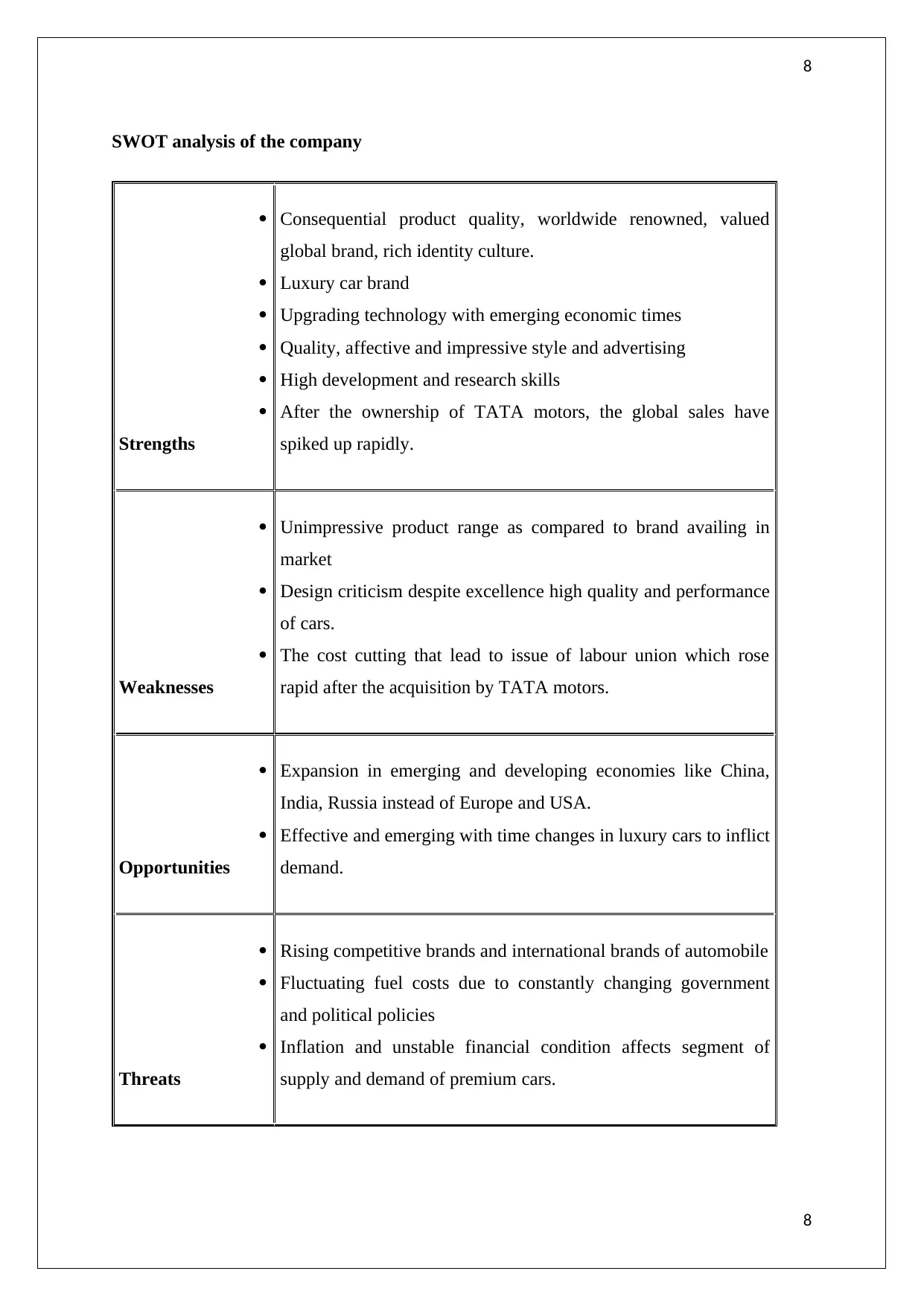
8
SWOT analysis of the company
Strengths
Consequential product quality, worldwide renowned, valued
global brand, rich identity culture.
Luxury car brand
Upgrading technology with emerging economic times
Quality, affective and impressive style and advertising
High development and research skills
After the ownership of TATA motors, the global sales have
spiked up rapidly.
Weaknesses
Unimpressive product range as compared to brand availing in
market
Design criticism despite excellence high quality and performance
of cars.
The cost cutting that lead to issue of labour union which rose
rapid after the acquisition by TATA motors.
Opportunities
Expansion in emerging and developing economies like China,
India, Russia instead of Europe and USA.
Effective and emerging with time changes in luxury cars to inflict
demand.
Threats
Rising competitive brands and international brands of automobile
Fluctuating fuel costs due to constantly changing government
and political policies
Inflation and unstable financial condition affects segment of
supply and demand of premium cars.
8
SWOT analysis of the company
Strengths
Consequential product quality, worldwide renowned, valued
global brand, rich identity culture.
Luxury car brand
Upgrading technology with emerging economic times
Quality, affective and impressive style and advertising
High development and research skills
After the ownership of TATA motors, the global sales have
spiked up rapidly.
Weaknesses
Unimpressive product range as compared to brand availing in
market
Design criticism despite excellence high quality and performance
of cars.
The cost cutting that lead to issue of labour union which rose
rapid after the acquisition by TATA motors.
Opportunities
Expansion in emerging and developing economies like China,
India, Russia instead of Europe and USA.
Effective and emerging with time changes in luxury cars to inflict
demand.
Threats
Rising competitive brands and international brands of automobile
Fluctuating fuel costs due to constantly changing government
and political policies
Inflation and unstable financial condition affects segment of
supply and demand of premium cars.
8
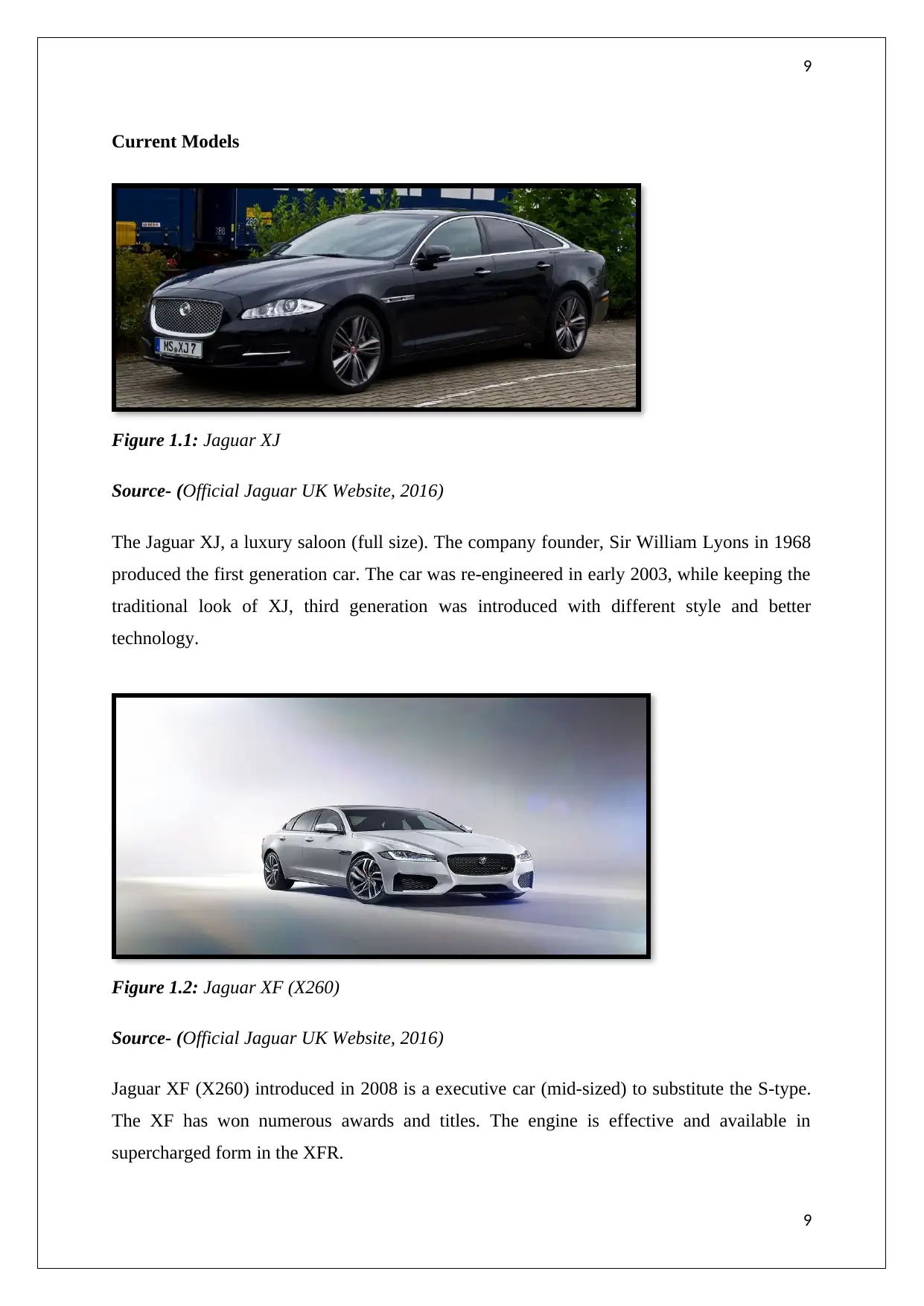
9
Current Models
Figure 1.1: Jaguar XJ
Source- (Official Jaguar UK Website, 2016)
The Jaguar XJ, a luxury saloon (full size). The company founder, Sir William Lyons in 1968
produced the first generation car. The car was re-engineered in early 2003, while keeping the
traditional look of XJ, third generation was introduced with different style and better
technology.
Figure 1.2: Jaguar XF (X260)
Source- (Official Jaguar UK Website, 2016)
Jaguar XF (X260) introduced in 2008 is a executive car (mid-sized) to substitute the S-type.
The XF has won numerous awards and titles. The engine is effective and available in
supercharged form in the XFR.
9
Current Models
Figure 1.1: Jaguar XJ
Source- (Official Jaguar UK Website, 2016)
The Jaguar XJ, a luxury saloon (full size). The company founder, Sir William Lyons in 1968
produced the first generation car. The car was re-engineered in early 2003, while keeping the
traditional look of XJ, third generation was introduced with different style and better
technology.
Figure 1.2: Jaguar XF (X260)
Source- (Official Jaguar UK Website, 2016)
Jaguar XF (X260) introduced in 2008 is a executive car (mid-sized) to substitute the S-type.
The XF has won numerous awards and titles. The engine is effective and available in
supercharged form in the XFR.
9
⊘ This is a preview!⊘
Do you want full access?
Subscribe today to unlock all pages.

Trusted by 1+ million students worldwide
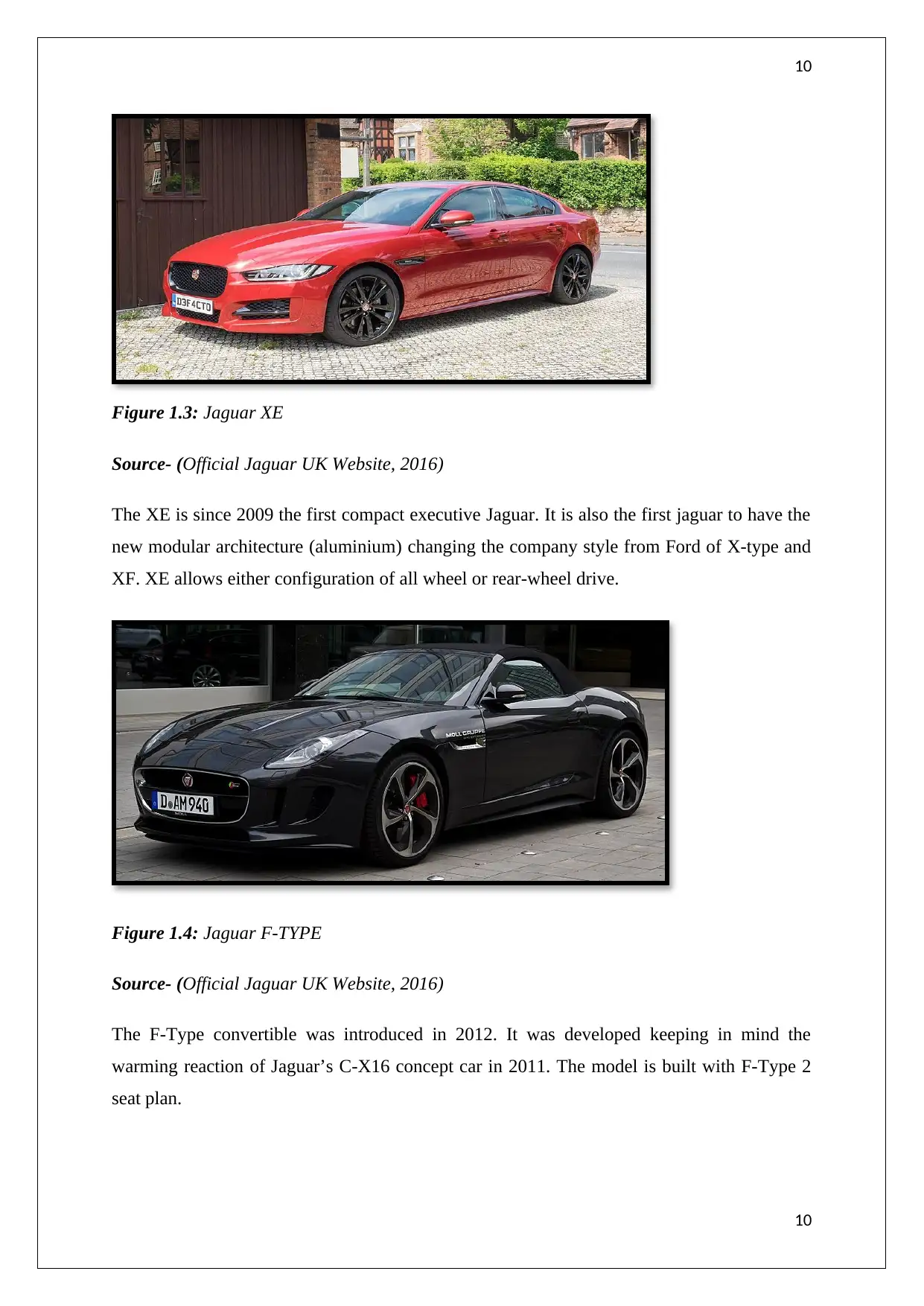
10
Figure 1.3: Jaguar XE
Source- (Official Jaguar UK Website, 2016)
The XE is since 2009 the first compact executive Jaguar. It is also the first jaguar to have the
new modular architecture (aluminium) changing the company style from Ford of X-type and
XF. XE allows either configuration of all wheel or rear-wheel drive.
Figure 1.4: Jaguar F-TYPE
Source- (Official Jaguar UK Website, 2016)
The F-Type convertible was introduced in 2012. It was developed keeping in mind the
warming reaction of Jaguar’s C-X16 concept car in 2011. The model is built with F-Type 2
seat plan.
10
Figure 1.3: Jaguar XE
Source- (Official Jaguar UK Website, 2016)
The XE is since 2009 the first compact executive Jaguar. It is also the first jaguar to have the
new modular architecture (aluminium) changing the company style from Ford of X-type and
XF. XE allows either configuration of all wheel or rear-wheel drive.
Figure 1.4: Jaguar F-TYPE
Source- (Official Jaguar UK Website, 2016)
The F-Type convertible was introduced in 2012. It was developed keeping in mind the
warming reaction of Jaguar’s C-X16 concept car in 2011. The model is built with F-Type 2
seat plan.
10
Paraphrase This Document
Need a fresh take? Get an instant paraphrase of this document with our AI Paraphraser
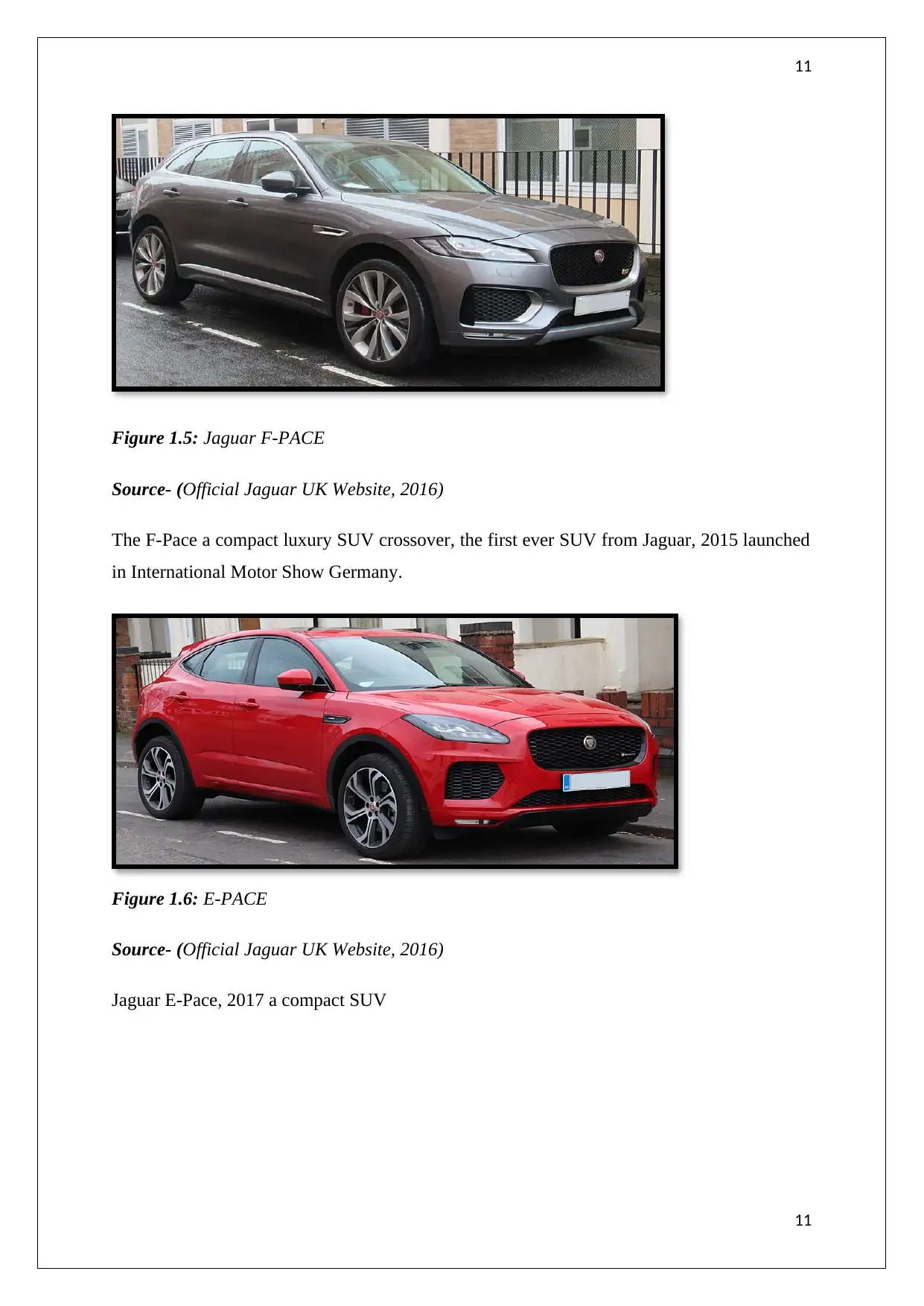
11
Figure 1.5: Jaguar F-PACE
Source- (Official Jaguar UK Website, 2016)
The F-Pace a compact luxury SUV crossover, the first ever SUV from Jaguar, 2015 launched
in International Motor Show Germany.
Figure 1.6: E-PACE
Source- (Official Jaguar UK Website, 2016)
Jaguar E-Pace, 2017 a compact SUV
11
Figure 1.5: Jaguar F-PACE
Source- (Official Jaguar UK Website, 2016)
The F-Pace a compact luxury SUV crossover, the first ever SUV from Jaguar, 2015 launched
in International Motor Show Germany.
Figure 1.6: E-PACE
Source- (Official Jaguar UK Website, 2016)
Jaguar E-Pace, 2017 a compact SUV
11
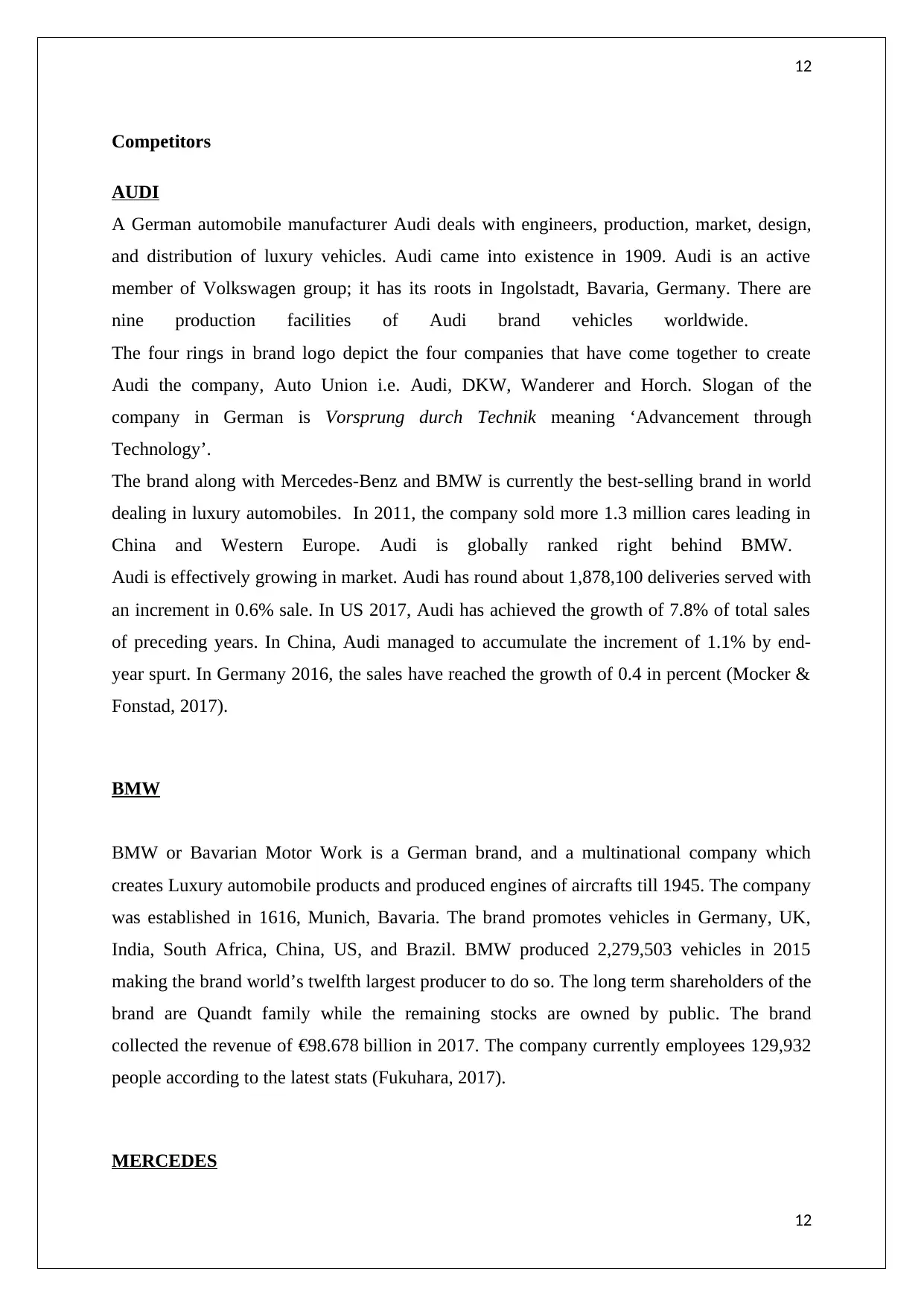
12
Competitors
AUDI
A German automobile manufacturer Audi deals with engineers, production, market, design,
and distribution of luxury vehicles. Audi came into existence in 1909. Audi is an active
member of Volkswagen group; it has its roots in Ingolstadt, Bavaria, Germany. There are
nine production facilities of Audi brand vehicles worldwide.
The four rings in brand logo depict the four companies that have come together to create
Audi the company, Auto Union i.e. Audi, DKW, Wanderer and Horch. Slogan of the
company in German is Vorsprung durch Technik meaning ‘Advancement through
Technology’.
The brand along with Mercedes-Benz and BMW is currently the best-selling brand in world
dealing in luxury automobiles. In 2011, the company sold more 1.3 million cares leading in
China and Western Europe. Audi is globally ranked right behind BMW.
Audi is effectively growing in market. Audi has round about 1,878,100 deliveries served with
an increment in 0.6% sale. In US 2017, Audi has achieved the growth of 7.8% of total sales
of preceding years. In China, Audi managed to accumulate the increment of 1.1% by end-
year spurt. In Germany 2016, the sales have reached the growth of 0.4 in percent (Mocker &
Fonstad, 2017).
BMW
BMW or Bavarian Motor Work is a German brand, and a multinational company which
creates Luxury automobile products and produced engines of aircrafts till 1945. The company
was established in 1616, Munich, Bavaria. The brand promotes vehicles in Germany, UK,
India, South Africa, China, US, and Brazil. BMW produced 2,279,503 vehicles in 2015
making the brand world’s twelfth largest producer to do so. The long term shareholders of the
brand are Quandt family while the remaining stocks are owned by public. The brand
collected the revenue of €98.678 billion in 2017. The company currently employees 129,932
people according to the latest stats (Fukuhara, 2017).
MERCEDES
12
Competitors
AUDI
A German automobile manufacturer Audi deals with engineers, production, market, design,
and distribution of luxury vehicles. Audi came into existence in 1909. Audi is an active
member of Volkswagen group; it has its roots in Ingolstadt, Bavaria, Germany. There are
nine production facilities of Audi brand vehicles worldwide.
The four rings in brand logo depict the four companies that have come together to create
Audi the company, Auto Union i.e. Audi, DKW, Wanderer and Horch. Slogan of the
company in German is Vorsprung durch Technik meaning ‘Advancement through
Technology’.
The brand along with Mercedes-Benz and BMW is currently the best-selling brand in world
dealing in luxury automobiles. In 2011, the company sold more 1.3 million cares leading in
China and Western Europe. Audi is globally ranked right behind BMW.
Audi is effectively growing in market. Audi has round about 1,878,100 deliveries served with
an increment in 0.6% sale. In US 2017, Audi has achieved the growth of 7.8% of total sales
of preceding years. In China, Audi managed to accumulate the increment of 1.1% by end-
year spurt. In Germany 2016, the sales have reached the growth of 0.4 in percent (Mocker &
Fonstad, 2017).
BMW
BMW or Bavarian Motor Work is a German brand, and a multinational company which
creates Luxury automobile products and produced engines of aircrafts till 1945. The company
was established in 1616, Munich, Bavaria. The brand promotes vehicles in Germany, UK,
India, South Africa, China, US, and Brazil. BMW produced 2,279,503 vehicles in 2015
making the brand world’s twelfth largest producer to do so. The long term shareholders of the
brand are Quandt family while the remaining stocks are owned by public. The brand
collected the revenue of €98.678 billion in 2017. The company currently employees 129,932
people according to the latest stats (Fukuhara, 2017).
MERCEDES
12
⊘ This is a preview!⊘
Do you want full access?
Subscribe today to unlock all pages.

Trusted by 1+ million students worldwide
1 out of 16
Related Documents
Your All-in-One AI-Powered Toolkit for Academic Success.
+13062052269
info@desklib.com
Available 24*7 on WhatsApp / Email
![[object Object]](/_next/static/media/star-bottom.7253800d.svg)
Unlock your academic potential
Copyright © 2020–2025 A2Z Services. All Rights Reserved. Developed and managed by ZUCOL.





